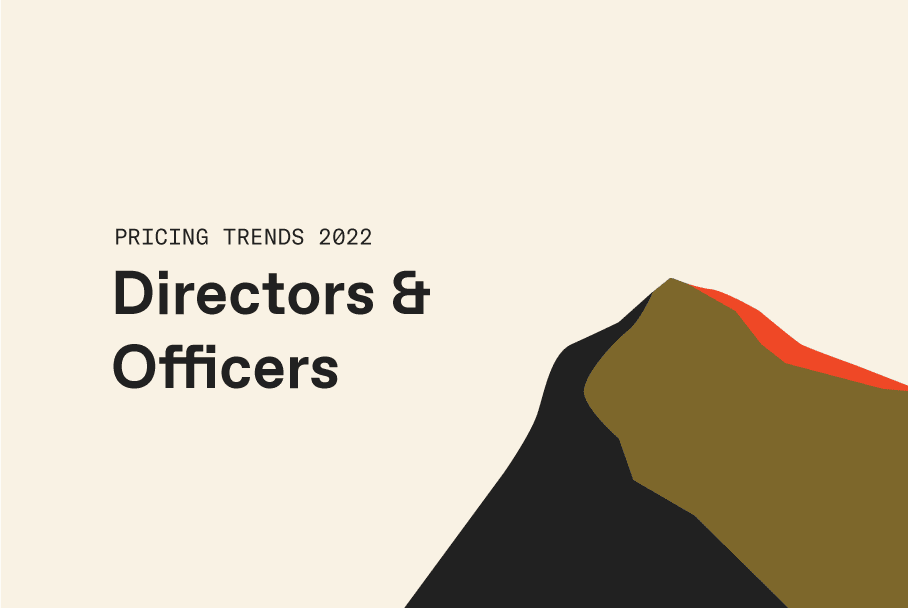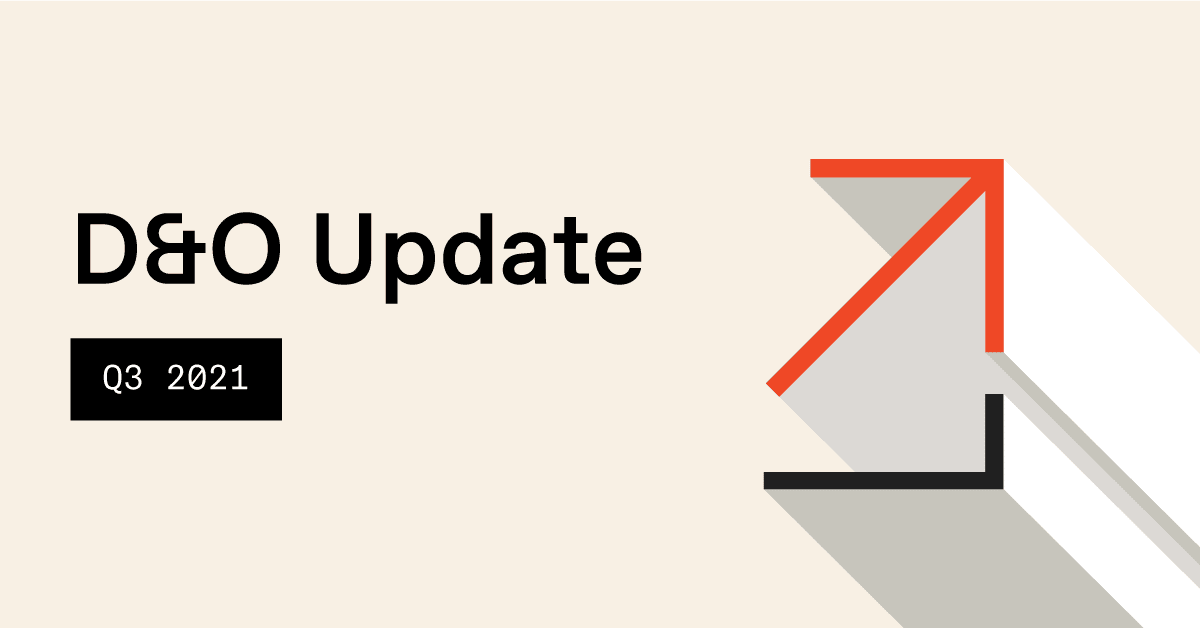Key Takeaways
Directors and Officers (D&O) faced an uptick of federal court securities class action lawsuits in 2023 with 213 filings, a marked increase from 2022. Looking ahead to 2024, as D&Os continue to face the threat of lawsuits, directors and officers (D&O) insurance becomes more of a necessity. In this post, we round up the factors of why you need D&O insurance, and the factors you need to look at.
What is D&O Insurance?
But first of all, what is D&O insurance? D&O stands for Directors and Officers liability insurance, providing protection for company managers against legal claims and liabilities resulting from their decisions and actions. This coverage shields individuals with managerial responsibilities from personal financial risks associated with litigation, offering support for defense costs, settlements, and awards arising from claims made against them.
What Does D&O Insurance Cost?
If you are looking for the short answer, the cost of Directors and Officers (D&O) insurance in the U.S. varies depending on several factors such as the type of business, company revenues, prior legal claims, and the amount of debt.
On average, the cost per million dollars of coverage for private companies with revenues up to $50 million falls between $5,000 to $10,000 annually. However, specific costs can differ based on individual circumstances and coverage needs. Following is a breakdown of the seven costs and drivers of D&O insurance.
7 Costs and Drivers of D&O Insurance Claim
The costs and drivers of Directors and Officers (D&O) insurance claims are influenced by various factors that impact the pricing and coverage of these policies. Factors such as the industry in which a company operates, its financial stability, litigation history, the company’s stage of development, and international involvement play crucial roles in determining the cost of D&O insurance
Additionally, the nature of the company, its size, and the trading pattern can significantly affect the premiums and coverage provided by D&O insurance policies. But the following are the few crucial factors that impact D&O insurance costs — and some of the most vital for company leaders to know.
1. Industry
What sector of the market does your company serve? This element might influence your D&O insurance cost more than you know. For example, the investment banking and securities industry frequently expose company leaders to many risks, more than other sectors.
Additionally, the life sciences industry faces mounds of unique risks, including those relating to royalties, licensing agreements, venture capital (VC) investor backing, etc. Insurers are well aware of these vulnerabilities and will often respond by increasing the cost of D&O insurance.
2. The Company’s Stage
Younger companies tend to have less experience and a shorter time frame, proving their risk management plan’s effectiveness. Even though some board of director members might have plenty of experience under their belts, underwriters often view younger companies as “fresh faces.” Moreover, they’ll view newer businesses as riskier to insure than well-developed companies, for example.
Typically, older and more developed businesses have experienced directors and officers, and thus, pose less risk than the newbies, per se. That said, your company’s development stage plays a significant role in what drives the cost of D&O insurance.
3. Financial Stability
As mentioned, life sciences companies can burn through VC funding faster than a wildfire, mostly early in the clinical trials process. It’s the nature of the business, and insurers acknowledge this distinct fact. Debt is also another underwriting consideration not to go unmentioned.
Part of D&O coverage offers corporate indemnification. This portion protects directors and officers, so their personal assets aren’t at stake. Though unstable finances could change a company’s risk level, making insolvency a genuine threat in a lawsuit.
4. Litigation History
As you may have guessed, your company’s legal history could keep you from landing the best D&O insurance premiums. Previous lawsuits and shifts in leadership impact D&O insurance rates significantly.
An excellent approach is being forthcoming with questionable business developments clouding your past — because underwriters will uncover them anyway. But even underwriters possess some level of understanding, analyzing your litigation history with a merciless fine-toothed comb in one hand and a dose of empathy in the other.
5. Private vs. Public
No matter if your company has undergone an initial public offering (IPO) or not, your directors and officers still face plenty of risks. However, the exposures undoubtedly increase for public company leaders. A lot rides on directors and officers during and after an IPO. The company might not meet expectations, disappointing loads of shareholders. In short, leaders are at the helm of their company, which makes them more vulnerable than mere employees.
6. Employee Pool Size
Employment-related claims are one of the leading causes of D&O lawsuits. And this trend shows no signs of slowing down anytime soon. The more significant your employee pool, the more chance your directors and officers will come under fire with legal issues.
Data analysis is vital to ensure you’ve got enough D&O coverage to protect your business from employment-related lawsuits. Some companies buy too much insurance, while others don’t purchase enough. For this reason, it’s best to analyze your employment-related risks intricately (or hire someone to investigate them for you).
7. International Involvement
Lastly, do your services or products cross the big blue, per se? If so, this aspect of international involvement can quickly complicate the D&O underwriting process. Your company must comply with domestic laws as well as regulations in other countries. Naturally, these factors add a few layers of complexity to your D&O insurance needs.
What’s Covered Under D&O Insurance?
- Legal Representation Costs: D&O insurance covers expenses for legal representation in case of lawsuits or legal actions against company executives.
- Company Reimbursement: D&O insurance can provide reimbursement to the company for indemnifying directors and officers, protecting the organization’s financial interests.
- Investigations: Coverage extends to investigations related to health and safety legislation, ensuring protection for board members and executives during such inquiries.
- Shareholder Claims: D&O insurance safeguards against claims of negligence from shareholders or investors, covering compensation and legal costs.
- Regulatory Compliance: It includes protection for alleged non-compliance with laws or regulations, helping mitigate risks associated with regulatory actions.
- Pension Management: Coverage may extend to investigations into the management of company pensions, offering financial support in case of legal challenges.
- Securities Litigation: D&O insurance can assist in cases of securities litigation, providing coverage for defense costs and potential settlements.
- Fiduciary Duties: Protection is offered for breaches of fiduciary duties by directors and officers, helping shield personal assets from legal claims.
- Risk Mitigation: D&O insurance helps mitigate risks associated with misrepresentation allegations, regulatory scrutiny, and other liabilities faced by company leadership.
Does D&O Insurance Cover Board Members?
This is a common question. The short answer is: Yes. Directors and Officers (D&O) insurance does cover board members, executives, and other company officers against legal actions taken against them for alleged wrongful acts committed in their positions.
It is not to be mistaken with board member liability insurance or board liability insurance, which is a broader term, encompassing various insurance policies that protect board members from liabilities related to their positions, including D&O insurance. Essentially, D&O insurance is a type of board liability insurance that focuses on protecting directors and officers from legal actions and financial losses resulting from their decisions and actions within the company
The Directors & Officers (D&O) insurance provides a safety net for directors and officers who may face legal challenges or increased scrutiny, offering protection for their personal assets in case they are personally sued for actions or decisions made in the course of their duties
How Much D&O Insurance Do I Need?
While every company has unique needs, it’s best to familiarize yourself with your D&O insurance policy. Tailor your D&O coverage based on your specific risks. For example, know your limits of liability and be aware of any exclusions. This approach will help you formulate an adequate D&O policy that will protect what needs protecting. Keep in mind that D&O coverage features three parts, including:
- Side A: Suppose directors are personally sued and are forced to pay defense costs and settlements, this portion of D&O insurance kicks in to protect the individual. However, Side A will only pay the individual directors if the entity can’t, such as if the company is insolvent. Many pre-IPO companies opt for additional Side A coverage limits, which is an excellent option.
- Side B: When the company (or entity) indemnifies individuals named in the lawsuit, Side B coverage reimburses those costs. But it only extends to indemnifying insured individuals named in the lawsuit.
- Side C: This coverage provides a balance sheet protection for the company named in a lawsuit alongside an individual director. Side C D&O coverage will reimburse the costs and settlements incurred.
Understanding the details of what D&O coverage your company needs can be a confusing process. Founder Shield specializes in knowing the risks your industry faces to make sure you have adequate protection. Feel free to reach out to us, and we’ll walk you through the process of finding the right policy for you.
Are D&O Claims Increasing?
The short answer is yes, no doubt. However, understanding this phenomenon requires a deeper dive into industry dynamics. First, let’s examine why D&O lawsuits happen in the first place. Whether a company is private or public, executives and board of directors members guide companies to success. As a result, they experience a growing amount of crossfire and for plenty of reasons, including:
- Wrongful acts
- Errors in judgment
- Breach of fiduciary duties
- Improper management
- Employment-related lawsuits
- Issues relating to the Employment Retirement Income Security Act (ERISA)
- Breaking government rules and regulations
Additionally, it’s not merely social inflation that’s impacting D&O trends. Attorney and Executive VP at RT ProExec, Kevin LaCroix, predicted an uptick in D&O claims due to the COVID-19 outbreak. What’s more, he explains, “Though the number of coronavirus-related securities suits so far is relatively modest, a number of patterns have emerged.” These patterns mean companies might experience a rise in premium rates, as well.
On top of that, companies pay lawyers a minimum average of $35,000 to $100,000 to defend each incident. Plus, indemnity payments average around $500,000 but can quickly skyrocket to seven figures or higher. Lamentably, D&O claims are increasing in cost as well as frequency.
If you’re ready for a customized D&O insurance quote, Founder Shield Specialists can help. It only takes a few minutes to get started. Request your tailored D&O insurance quote today!









